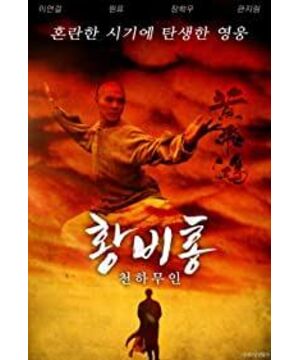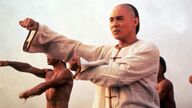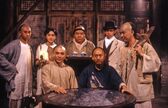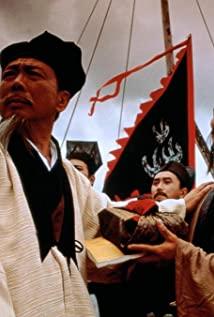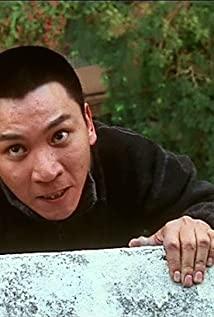In fact, as early as the 1940s, Huang Feihong's image was already active on the big screen. In 1949, the first "Once Upon a Time" film "Once Upon a Time in the First Episode: The Whip and the Candle" was born. By 2014, "Once Upon a Time in Heroes of Huang Feihong" starring Eddie Peng was already the 101st "Once Upon a Time Film". Movie. Among the 101 films, 77 are starring Master Guan Dexing.
Guan Dexing (June 27, 1905 - June 1996), a Hong Kong film and television actor. He is a Shaolin martial artist. Known for starring in the biographical series of martial artist Wong Fei Hung (87 episodes in total). In 1976, he filmed the TV series "Once Upon a Time" in Hong Kong TVB. In addition, he also played Huang Feihong in the films "The Brave" Two Dragons 1979 and "Lin Shirong" The Magnificent Butcher 1979.
Most of Huang Feihong played by Master Guan Dexing is a majestic patriarchal image. Compared with the breakthrough, in 1987 Yuan Heping directed Jackie Chan's "Drunken Fist". Jackie Chan's Wong Fei-hung combines martial arts with comedy, and the appearance of "Drunken Boxing" marks that kung fu comedy has officially become a genre of Hong Kong movies.
It can be said that before Tsui Hark created "Once Upon a Time", the "Once Upon a Time Film" was already a very successful series of films, with pearls and jade in the front. The reason why we see the 1991 version of "Once Upon a Time" today is that after 5 years of polishing the script, Tsui Hark gave Huang Feihong a higher level as a hero. It now appears that although the production of Tsui Hark's first "Once Upon a Time" is a little rough, its text is excellent, and its photography style is very prominent. Makes blood boil. Basically laid the foundation of all Tsui Hark's Wong Fei Hung films.
Different from the past, Tsui Hark portrayed Huang Feihong as a hero who "worries before the world and worries", making Huang Feihong an iconic figure carrying the spirit of traditional Chinese Confucianism.
If you taste Tsui Hark's Huang Feihong carefully, you will find that he is a very "Confucian" person. He was stern to his apprentices and respectful to officials; when he discovered that civilians were accidentally injured by foreigners, he would make a claim; but when he was wronged, he would obediently cooperate with the government. In this version of Huang Feihong, I can see not only his responsibility to his country as a martial artist, but also his reverence for imperial power.
In Tsui Hark's "Once Upon a Time", Huang Feihong's enemies are divided into visible enemies and invisible enemies. Interestingly, the tangible enemies are not foreigners, but national scum like the Shahe Gang and Yan Zhendong. In this way, "Once Upon a Time" and "Wolf Warrior" are distinguished from films that rely solely on national sentiment as a support point. After watching "Once Upon a Time", the audience will also feel that in addition to the bad breath, but the audience's more profound experience is the education of "being a good man, warm-blooded and warm-hearted", because Huang Feihong is not beating foreigners but making money for the country National scum. Therefore, "Once Upon a Time" is more reflective and educational about the inferiority of the people.
Wong Fei-hung's invisible enemy is Western advanced science and technology. All tangible enemies did not make Huang Feihong uneasy, but one night, Huang Feihong was in a daze with a bullet in his hand, and then it turned into annoyance and confusion. This episode shows Huang Feihong's doubts about martial arts, himself, and even his reflection on the entire Chinese nation, who has been trained in martial arts. This coincides with the idea of "learning from the barbarians to control the barbarians" at that time, and it also has the cuteness of the "good face" of the traditional Chinese elders.
The success of this version of Huang Feihong is precisely because of the creator's dialectical thinking. Tsui Hark did not completely deny Chinese martial arts, nor did he consider the myth of martial arts, but allowed Huang Feihong to be eclectic. Huang Feihong was stubborn at first, but in the face of the facts he had to admit that "foreigners' guns are really powerful". So, in times of crisis, we see that Wong Fei-hung used to kill American businessmen precisely the bullets that were ejected from his fingers. At the end of the movie, he also listened to Aunt Thirteen and put on a dress. This marks Huang Feihong's broad-mindedness, acknowledging the shortcomings of China's science and technology, and knowing how to learn with an open mind. This is what a hero should be like, a role model for all self-improvement men.
Tsui Hark advanced Huang Feihong's life by several decades, in the late Qing Dynasty, the period of the Westernization Movement. In the turbulent times, the court, the underworld, foreigners, ordinary people, missionaries, etc. formed a map, and different values collided with each other.
The main line of the first "Huang Feihong" story is the grievances between Huang Feihong and the Shahe Gang. In the gradually escalating contradictions, the yamen's restrictions on Huang Feihong are interspersed; After the last aunt was tied to the boat, the two lines merged into one, and all contradictions were resolved at one time.
In the movie, we see that the Shahe Gang collects protection fees forcibly, colluded with the Americans to sell women, and made a lot of money; Yan Zhendong, a down-and-out martial artist, sold his fists and personality for money, and even called it "to help justice in the future". ; The Admiral was busy fighting infighting and cleaning up the militia; the common people acted as spectators, cheering on the side. The Shahe Gang and Yan Zhendong are the representatives of the rivers and lakes, and they have become the lackeys of the foreigners to assist the fish and meat villagers; the Admiral, of course, represents the government. boring spectator.
It can be said that it was a troubled world that could easily lead to disorientation. Such unease and sense of loss actually come from the projection of reality. In 1991, there was still a period of time before Hong Kong's return. However, as the return was approaching, Hong Kong people's unease about the return became more and more serious. Tsui Hark used the unease of the troubled times in the late Qing Dynasty to take care of the mentality of Hong Kong people before the return.
What is precious is that Tsui Hark did not magnify this unease. Traditional culture in Hong Kong is both inherited and post-colonial impact. The Huang Feihong created by Tsui Hark almost seeks a spiritual sustenance from the culture, and self-improvement is exactly the way out for this kind of anxiety that Tsui Hark is looking for.
In terms of image style, the most prominent feature of Tsui Hark's "Once Upon a Time" is the wide-angle lens shot upwards, making Huang Feihong tall and majestic. Then the "Once Upon a Time of Two Men: Be Self-improvement" and "Once Upon a Time in Three Lions Fight for Hegemony" all continued this style. It can be said that the 1991 "Once Upon a Time" brought a hero who can represent the traditional image of the Chinese nation to the screen, connecting the past and the future. It is worthy of being a classic in the history of Chinese films.
View more about Once Upon a Time in China reviews


